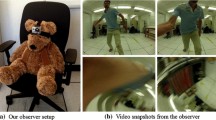Abstract
Many real applications involve simultaneous recording and analysis of multi-channel information sources. Learning and modeling the interactions among channels is the kernel step to analyze and recognize system characteristics. This paper presents a model that learns the dynamical influence among multi-channel sequences. The model, dynamical influence model, permits functional roles of individual channels to change and models the changing influence strength between channels. By querying the values of influence factors, we can recognize the functional role of each channel qualitatively and learn about to what extent the chains influence each other quantitatively at any time. The experimental results on synthetic data and application of multi-person interaction recognition show that our model is reliable and effective.
Similar content being viewed by others
References
Bengio S, Bourlard H. Multi-channel sequence processing. In: Deterministic and Statistical Methods in Machine Learning. Sheffield, UK, 2004. 22–36
Poh N, Bengio S. Why do multi-stream, multi-band and multi-modal approaches work on biometric user authentication tasks? In: Proc ICASSP, Montreal, QC, Canada, 2004. 893–896
Potamianos G, Neti C, Gravier G, et al. Recent advances in the automatic recognition of audio-visual speech. Proc IEEE, 2003, 91: 1306–1326
Brand M, Oliver N, Pentland A. Coupled hidden Markov models for complex action recognition. In: Proc CVPR, San Juan, Puerto Rico, 1997. 994–999
Vogler C, Metaxas D. Parallel hidden Markov models for American sign language recognition. In: Proc ICCV, Kerkyra, Corfu, Greece, 1999. 224–228
Asavathiratham C, Roy S, Lesieutre B. The influence model. IEEE Control Syst Mag, 2001, 21: 52–64
Basu S, Choudhury T, Clarkson B, et al. Learning human interactions with the influence model. In: Proc NIPS Vancouver, British Columbia, Canada, 2001
Choudhury T, Basu S. Modeling conversational dynamics as a mixed-memory Markov process. In: Proc NIPS, Vancouver, Canada, 2004. 281–288
Tian Y, Mei Z, Huang T, et al. Incremental learning for interaction dynamics with the influence model. In: Proc. SIGKDD, Washington, DC, USA, 2003
Dong W, Pentland A. Modeling influence between experts. In: AI for Human Computing, LNAI, Hyderadab, India, 2007. 170–189
Dong W, Lepri B, Cappelletti A, et al. Using the influence model to recognize functional roles in meetings. In: Proc. ICMI, Nagoya, Japan, 2007. 271–278
Rienks R, Zhang D, Gatica-Perez D, et al. Detection and application of influence ranking in small group meetings. In: Proc. ICMI, Banff, Alberta, Canada, 2006. 257–264
Bradicka O, Maisonnasse J, Reignier P. Automatic detection of influence groups. In: Proc. ICMI, Trento, Italy, 2005
Lee M, Ofsche R. The impact of behavioral style and status characteristics on social influence: a test of two competing theories. Social Psych Quart, 1981, 44: 73–82
Odell J, Parunak H V, Brueckner S, et al. Changing roles: dynamic role assignment. J Object Tech, 2003, 2: 77–86
Saul L K, Jordan M I. Mixed memory Markov models: decomposing complex stochastic processes as mixtures of simpler ones. Mach Learn, 1999, 37: 75–87
Rachel A M. Mixed hidden Markov models: an extension of the hidden Markov model to the longitudinal data setting. J Am Stat Assoc, 2007, 102: 201–210
Murphy K P. Dynamic Bayesian networks: representation, inference and learning. Phd thesis, University of California at Berkeley, Computer Science Division, 2002
Zhang W, Chen F, Xu W, et al. Real-time video intelligent surveillance system. In: Proc. ICME, Toranto, Ontario, Canada, 2006. 1021–1024
Zhang W, Chen F, Xu W, et al. Decomposition in hidden Markov models for activity recognition. In: Proc. MCAM, Weihai, Shandong, China, 2007. 232–241
Zhang W, Chen F, Xu W. Hierarchical group process representation in multi-agent activity recognition. Signal Process Image Commun, 2008, 23: 739–753
Author information
Authors and Affiliations
Corresponding author
Rights and permissions
About this article
Cite this article
Zhang, W., Chen, F. & Xu, W. Learning interactions among multi-channel sequences with dynamical influence models. Sci. China Inf. Sci. 53, 1336–1344 (2010). https://doi.org/10.1007/s11432-010-4008-7
Received:
Accepted:
Published:
Issue Date:
DOI: https://doi.org/10.1007/s11432-010-4008-7




